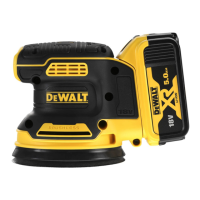33
ENGLISH
CAUTION: Never operate this sander unless a dust
collector is in place. Sanding dust exhaust may create a
breathinghazard.
OPERATION
Instructions for Use
WARNING: Always observe the safety instructions and
applicableregulations.
WARNING: To reduce the risk of serious personal
injury, turn tool off and disconnect battery pack
before making any adjustments or removing/
installing attachments or accessories. An accidental
start-up can causeinjury.
Proper Hand Position (Fig. F)
WARNING: To reduce the risk of serious personal injury,
ALWAYS use proper hand position asshown.
WARNING: To reduce the risk of serious personal
injury, ALWAYS hold securely in anticipation of a
suddenreaction.
Proper hand position requires one hand on the main grip
asshown.
Operating the Sander (Fig. F)
NOTICE: These sanders are not to be used in
drywallapplications.
NOTICE: Avoid overloading your sander. Overloading
will result in a considerable reduction in speed and finish
quality of your work. The unit may also become hot. In
this event, run sander at a no load condition for a minute
ortwo.
To operate your sander, grasp it as shown in Figure F and turn it
on. Move the sander in long, sweeping strokes along the surface
being sanded, letting the sander do thework.
Pushing down on the tool while sanding actually slows the
removal rate and produces an inferior quality surface. Be sure
to check your work often, this sander is capable of removing
material rapidly, especially with coarsepaper.
The random orbital action of your sander allows you to sand
with the grain or at any angle across it for most sanding jobs. To
produce the best finish possible, start with coarse grit sandpaper
and change gradually to finer and finer paper. Vacuum and
wipe surface with a tack cloth between grit steps. Your sander is
designed to sand into small or confined areas. Its small size and
light weight make it ideal for overheadwork.
The rate at which the dust collection bag fills up will vary with
the type of material being sanded and the coarseness of the
sandpaper. For best results, empty the bag frequently. When
sanding painted surfaces, (see the following for additional
precautions when sanding paint) you may find that the
sandpaper loads up and clogs with paint. A heat gun will work
much better to remove paint before sanding. FOLLOW ALL
SAFETY INSTRUCTIONS IN HEAT GUN INSTRUCTIONMANUAL.
Precautions to Take When Sanding Paint
Sanding of lead based paint is NOT RECOMMENDED due to the
difficulty of controlling the contaminated dust. The greatest
danger of lead poisoning is to children and pregnantwomen.
Since it is difficult to identify whether or not a paint contains
lead without a chemical analysis, we recommend the following
precautions when sanding any paint:
1. PERSONAL SAFETY
- No children or pregnant women should enter the work
area where the paint sanding is being done until all
clean up iscompleted.
- A dust mask or respirator should be worn by all persons
entering the work area. The filter should be replaced
daily or whenever the wearer has difficulty breathing.
See your local hardware store for the proper NIOSH-
approved dustmask.
- NO EATING, DRINKING or SMOKING should be done in
the work area to prevent ingesting contaminated paint
particles. Workers should wash and clean up BEFORE
eating, drinking or smoking. Articles of food, drink, or
smoking should not be left in the work area where dust
would settle onthem.
2. ENVIRONMENTAL SAFETY
- Paint should be removed in such a manner as to
minimize the amount of dustgenerated.
- Areas where paint removal is occurring should be sealed
with plastic sheeting of 4 milsthickness.
- Sanding should be done in a manner to reduce tracking
of paint dust outside the workarea.
3. CLEANING AND DISPOSAL
- All surfaces in the work area should be vacuumed
and thoroughly cleaned daily for the duration of
the sanding project. Vacuum filter bags should be
changedfrequently.
- Plastic drop cloths should be gathered up and disposed
of along with any dust chips or other removal debris.
They should be placed in sealed refuse receptacles and
disposed of through regular trash pick-up procedures.
During clean up, children and pregnant women should
be kept away from the immediate workarea.
- All toys, washable furniture and utensils used by
children should be washed thoroughly before being
usedagain.
MAINTENANCE
Your
power tool has been designed to operate
over a long period of time with a minimum of maintenance.
Continuous satisfactory operation depends upon proper tool
care and regularcleaning.
WARNING: To reduce the risk of serious personal
injury, turn tool off and disconnect battery pack
before making any adjustments or removing/
installing attachments or accessories. An accidental
start-up can causeinjury.

